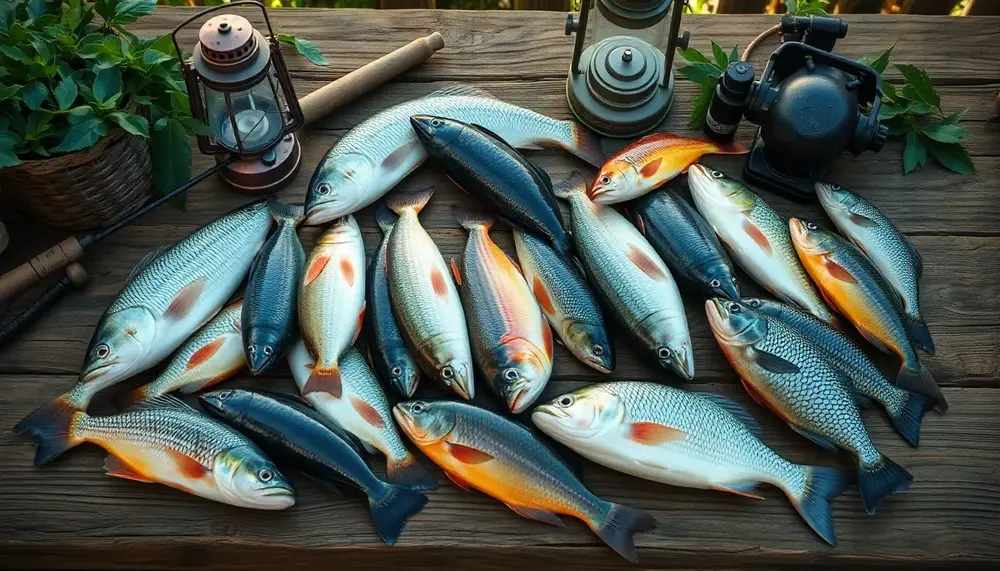Table of Contents:
Introduction to Common Fish Species
So, you're curious about fish, huh? Well, dive right in! Fish are more than just creatures swimming in water; they're a vibrant part of our ecosystem, each with its own unique quirks and characteristics. From the shimmering scales of the African Pompano to the elongated body of the Agujon Needlefish, the diversity is simply mind-boggling. But why does it matter? Understanding these species isn't just for biologists or anglers; it's for anyone who wants to appreciate the intricate tapestry of life beneath the waves.
Imagine a world where you can identify a fish just by its snout shape or the way it glides through the water. Sounds fascinating, right? This isn't just about ticking names off a list; it's about connecting with nature on a deeper level. Whether you're a seasoned fisherman or a curious observer, knowing about common fish species opens up a whole new world of exploration and conservation. So, let's get our feet wet and explore the fascinating world of fish species!
Key Characteristics of Fish Species
Alright, let's talk fish features! Fish are like the fashionistas of the aquatic world, each flaunting their own set of distinctive traits. These characteristics are not just for show; they play crucial roles in their survival and adaptation. So, what should you look out for?
First up, the body shape. Is it streamlined like a torpedo or flat like a pancake? Streamlined bodies are perfect for fast swimmers, while flat bodies help fish hide on the ocean floor. Then there's the coloration. Bright colors can be a warning to predators or a way to attract mates, while dull colors might help a fish blend into its surroundings.
Don't forget about the fins. The size and shape of fins can tell you a lot about a fish's lifestyle. Long, slender fins might indicate a fish that glides gracefully through the water, while shorter, robust fins could suggest a fish that needs power and agility to navigate rocky crevices.
And, of course, the mouth. A fish's mouth can reveal its feeding habits. Is it a predator with sharp teeth or a bottom feeder with a sucker-like mouth? Each mouth type is perfectly adapted to the fish's diet and habitat.
So, next time you're peering into an aquarium or casting a line, take a moment to appreciate these key characteristics. They're not just fascinating; they're the result of millions of years of evolution, each feature a testament to the adaptability and resilience of fish species.
Diverse Habitats of Common Fish
Fish habitats are as varied as the fish themselves, ranging from the sunlit shallows to the mysterious depths of the ocean. Each habitat presents its own set of challenges and opportunities, shaping the lives of the fish that call it home. Let's take a closer look at these diverse environments.
First, we have the inland waters, which include rivers, lakes, and streams. These habitats are often bustling with life, providing a haven for species like the Largemouth Bass. The calm, warm waters are perfect for fish that prefer a leisurely pace, surrounded by vegetation and debris that offer both food and shelter.
Then there are the coastal areas, where the land meets the sea. These regions are dynamic and ever-changing, with tides and currents creating a unique environment. Fish here, like the Alligator Gar, have adapted to thrive in both fresh and saltwater, showcasing incredible versatility.
Moving further out, we encounter the offshore reefs. These vibrant underwater cities are teeming with life, offering a rich tapestry of colors and textures. Fish like the African Pompano find refuge among the corals, navigating the complex structures with ease.
Lastly, the ocean floor presents a world of its own. It's a place of extremes, where pressure and darkness reign. Yet, even here, life flourishes. Species like the American Angler have adapted to these harsh conditions, using bioluminescence to lure prey in the pitch-black depths.
Each habitat is a testament to the adaptability of fish, showcasing their ability to thrive in environments that range from tranquil to tumultuous. Understanding these habitats not only enriches our knowledge of fish species but also highlights the importance of preserving these diverse ecosystems for future generations.
Examples of Common Fish Species
Let's dive into some fascinating examples of common fish species that populate our waters. These species are not just abundant; they each have unique stories and roles within their ecosystems.
- Largemouth Bass: Known for its voracious appetite and aggressive nature, the Largemouth Bass is a favorite among anglers. Its adaptability to various freshwater environments makes it a prevalent species across many regions.
- Alligator Gar: With its elongated body and fearsome appearance, the Alligator Gar is a true survivor. This ancient fish has a dual respiratory system, allowing it to gulp air when oxygen levels in the water are low.
- American Eel: The American Eel is a mysterious traveler, known for its long migrations. From freshwater rivers to the salty depths of the Sargasso Sea, this species showcases incredible endurance and adaptability.
- African Pompano: A shimmering spectacle in offshore waters, the African Pompano is admired for its striking appearance and swift movements. It thrives in reef habitats, where it navigates the complex structures with agility.
- Albacore Tuna: This species is a true ocean wanderer, known for its long-distance migrations across the open sea. The Albacore Tuna is prized for its meat and plays a significant role in commercial fishing industries.
These examples highlight the diversity and adaptability of fish species. Each one plays a vital role in its ecosystem, contributing to the intricate balance of aquatic life. By understanding these species, we gain insight into the complex web of life that sustains our planet's waters.
Conservation and Education in Fish Species
Conservation and education go hand in hand when it comes to protecting our fish species. It's not just about keeping fish populations healthy; it's about ensuring that future generations can enjoy and learn from these incredible creatures. So, what can we do?
First, let's talk about conservation efforts. Many organizations are working tirelessly to preserve fish habitats and maintain biodiversity. This includes initiatives like habitat restoration, pollution control, and sustainable fishing practices. By supporting these efforts, we can help ensure that fish populations remain robust and resilient.
Education plays a crucial role too. By spreading awareness about the importance of fish species and their habitats, we can inspire more people to take action. Schools, aquariums, and nature centers often provide educational programs that teach about the life cycles, behaviors, and ecological roles of fish. These programs are vital for fostering a sense of stewardship and responsibility towards our aquatic environments.
- Community Involvement: Engaging local communities in conservation projects can have a significant impact. Whether it's participating in a river cleanup or attending a workshop on sustainable fishing, every little bit helps.
- Research and Monitoring: Scientific research is essential for understanding fish populations and their needs. By supporting research initiatives, we can gather valuable data that informs conservation strategies.
- Policy and Advocacy: Advocating for policies that protect fish habitats and regulate fishing practices is crucial. By staying informed and voicing our concerns, we can influence decision-makers to prioritize conservation.
Ultimately, conservation and education are about creating a sustainable future for our fish species. By working together, we can ensure that these fascinating creatures continue to thrive in their natural habitats, enriching our world with their presence.
How to Use Fish Charts Effectively
Fish charts are like treasure maps for anyone interested in aquatic life. They offer a wealth of information at a glance, but using them effectively requires a bit of know-how. Here's how you can make the most out of these handy tools.
First things first, familiarize yourself with the layout. Most fish charts are organized by categories such as habitat, size, or family. Understanding this structure will help you quickly locate the information you need.
- Identify Key Features: Look for distinguishing characteristics such as body shape, fin placement, and coloration. These details are often highlighted in charts to aid in quick identification.
- Use Visual Aids: Many charts include illustrations or photographs. These visuals can be incredibly helpful, especially when trying to differentiate between similar species.
- Cross-Reference Information: If you're unsure about a particular species, use the chart in conjunction with other resources like field guides or mobile apps. This can provide a more comprehensive understanding.
When you're out in the field, keep a portable chart handy. Whether it's a laminated card or a digital version on your phone, having quick access to a chart can make all the difference in identifying fish on the spot.
Finally, practice makes perfect. The more you use fish charts, the more familiar you'll become with the species and their characteristics. Over time, you'll develop a keen eye for spotting even the most elusive fish.
So, grab a chart and start exploring! With a little practice, you'll be identifying fish like a pro in no time.
Conclusion: Understanding Fish for Better Conservation
Understanding fish is more than just an academic exercise; it's a vital step towards ensuring their conservation. By learning about the diverse species, their habitats, and the challenges they face, we can take informed actions to protect them. This knowledge empowers us to make decisions that benefit not only the fish but the entire ecosystem.
When we delve into the world of fish, we begin to see the intricate connections that sustain life underwater. Each species plays a unique role, contributing to the balance and health of aquatic environments. Recognizing these roles helps us appreciate the importance of conservation efforts and the need for sustainable practices.
Moreover, education and awareness are powerful tools. By sharing what we know, we can inspire others to join the cause. Whether it's through community projects, educational programs, or simply spreading the word, every effort counts. Together, we can create a ripple effect that leads to meaningful change.
In conclusion, understanding fish is not just about identifying species or memorizing facts. It's about fostering a deeper connection with the natural world and taking responsibility for its preservation. By doing so, we ensure that future generations can enjoy the beauty and diversity of our planet's waters, just as we do today.
Understanding Common Fish Species
What is the purpose of the Fish Identification Tool?
The Fish Identification Tool is designed to assist anglers, biologists, and educators in identifying various fish species found in Wisconsin. It provides resources for offline use through a mobile app.
Which features help identify fish species by appearance?
Fish species can be identified by appearance using features like snout shape, mouth type, body shape, coloration, and fin structure.
Where is the Largemouth Bass commonly found?
The Largemouth Bass is commonly found in quiet warm waters, streams, rivers, and lakes with vegetation or debris, and is widely distributed across Georgia.
What is the habitat of the African Pompano?
The African Pompano typically inhabits offshore reef environments, thriving in these ecosystems thanks to their complex structures.
How can engaging in conservation efforts benefit fish species?
Conservation efforts, such as habitat restoration and sustainable fishing practices, help maintain biodiversity and ensure robust and resilient fish populations.







